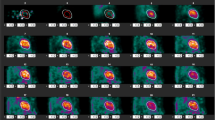Abstract
Purpose
Patient motion during dynamic PET studies is a well-documented source of errors. The purpose of this study was to investigate the incidence of frame-to-frame motion in dynamic 15O-water myocardial perfusion PET studies, to test the efficacy of motion correction methods and to study whether implementation of motion correction would have an impact on the perfusion results.
Methods
We developed a motion detection procedure using external radioactive skin markers and frame-to-frame alignment. To evaluate motion, marker coordinates inside the field of view were determined in each frame for each study. The highest number of frames with identical spatial coordinates during the study were defined as “non-moved”. Movement was considered present if even one marker changed position, by one pixel/frame compared with reference, in one axis, and such frames were defined as “moved”. We tested manual, in-house-developed motion correction software and an automatic motion correction using a rigid body point model implemented in MIPAV (Medical Image Processing, Analysis and Visualisation) software. After motion correction, remaining motion was re-analysed. Myocardial blood flow (MBF) values were calculated for both non-corrected and motion-corrected datasets.
Results
At rest, patient motion was found in 18% of the frames, but during pharmacological stress the fraction increased to 45% and during physical exercise it rose to 80%. Both motion correction algorithms significantly decreased (p<0.006) the number of moved frames and the amplitude of motion (p<0.04). Motion correction significantly increased MBF results during bicycle exercise (p<0.02). At rest or during adenosine infusion, the motion correction had no significant effects on MBF values.
Conclusion
Significant motion is a common phenomenon in dynamic cardiac studies during adenosine infusion but especially during exercise. Applying motion correction for the data acquired during exercise clearly changed the MBF results, indicating that motion correction is required for these studies.



Similar content being viewed by others
References
Cooper JA, Neumann PH, McCandless BK. Detection of patient motion during tomographic myocardial perfusion imaging. J Nucl Med 1993;34:1341–8
Leslie WD, Dupont JO, McDonald D, Peterdy AE. Comparison of motion correction algorithms for cardiac SPECT. J Nucl Med 1997;38:785–90
O’Connor MK, Kanal KM, Gebhard MW, Rossman PJ. Comparison of four motion correction techniques in SPECT imaging of the heart: a cardiac phantom study. J Nucl Med 1998;39:2027–34
Matsumoto N, Berman DS, Kavanagh PB, Gerlach J, Hayes SW, Lewin HC, et al. Quantitative assessment of motion artifacts and validation of a new motion-correction program for myocardial perfusion SPECT. J Nucl Med 2001;42:687–94
Germano G, Chua T, Kavanagh PB, Kiat H, Berman DS. Detection and correction of patient motion in dynamic and static myocardial SPECT using a multi-detector camera. J Nucl Med 1993;34:1349–55
Turkington TG, DeGrado TR, Hanson MW, Coleman RE. Alignment of dynamic cardiac PET images for correction of motion. Nucl Sci IEEE Trans 1997;44:235–42
Menke M, Atkins MS, Buckley KR. Compensation methods for head motion detected during PET imaging. IEEE Trans Nucl Sci 1996;43:310–7
Picard Y, Thompson, CJ. Motion correction of PET images using multiple acquisition frames. IEEE Trans Med Imag 1997;16:137–44
Clark JC, Crouzel C, Meyer GJ, Strijckmans K. Current methodology for oxygen-15 production for clinical use. Int J Rad Appl Instrum A 1987;38:597–600
Pinard E, Mazoyer B, Verrey B, Pappata S, Crouzel C. Rapid measurement of regional cerebral blood flow in the baboon using 15O-labelled water and dynamic positron emission tomography. Med Biol Eng Comput 1993;3:495–502
Spinks TJ, Jones T, Gilardi MC, Heatrec JD. Physical performance of the latest generation of commercial positron scanner. IEEE Trans Nucl Sci 1988;35:721–5
Alenius S, Ruotsalainen U. Bayesian image reconstruction for emission tomography based on median root prior. Eur J Nucl Med 1997;24:258–65
McAuliffe MJ, Lalonde FM, McGarry D, Gandler W, Csaky K, Trus BL. Medical image processing, analysis and visualization in clinical research. IEEE Computer-Based Med Syst 200:381–6
Arun KS, Huang TS, Blostein SD. Least-squares fitting of two 3-D point sets IEEE transactions on pattern analysis and machine intelligence, Vol. PAMI-9, No. 5, September, 1987, pp. 698–700
Britten AJ, Jamali F, Gane JN, Joseph AE. Motion detection and correction using multi-rotation 180° single-photon emission tomography for thallium myocardial imaging. Eur J Nucl Med 1998;25:1524–30
Iida H, Takahashi A, Tamura Y, Ono Y, Lammertsma AA. Myocardial blood flow: comparison of oxygen-15-water bolus injection, slow infusion and oxygen-15-carbon dioxide slow inhalation. J Nucl Med 1995;36:78–85
Iida H, Rhodes CG, de Silva R, Araujo LI, Bloomfield PM, Lammertsma AA, et al. Use of the left ventricular time-activity curve as a noninvasive input function in dynamic oxygen-15-water positron emission tomography. J Nucl Med 1992;33:1669–77
Bloomfield PM, Spinks TJ, Reed J, Schnorr L, Westrip AM, Livieratos L, et al. The design and implementation of a motion correction scheme for neurological PET. Phys Med Biol 2003;48(8):959–78
Lopresti BJ, Russo A, Jones WF, Fisher T, Crouch DG, Altenburger DE, et al. Implementation and performance of an optical motion tracking system for high resolution brain PET imaging. IEEE Trans Nucl Sci 1999;46:2059–67
Chareonthaitawee P, Kaufmann PA, Rimoldi O, Camici PG. Heterogeneity of resting and hyperemic myocardial blood flow in healthy humans. Cardiovasc Res 2001;50:151–61
Acknowledgements
We thank the staff of the Turku PET Centre for their excellent technical assistance.
This study was financially supported by grants from Turku University Hospital (EVO) and Finnish Foundation for Cardiovascular Research.
Author information
Authors and Affiliations
Corresponding author
Rights and permissions
About this article
Cite this article
Naum, A., Laaksonen, M.S., Tuunanen, H. et al. Motion detection and correction for dynamic 15O-water myocardial perfusion PET studies. Eur J Nucl Med Mol Imaging 32, 1378–1383 (2005). https://doi.org/10.1007/s00259-005-1846-4
Received:
Accepted:
Published:
Issue Date:
DOI: https://doi.org/10.1007/s00259-005-1846-4




